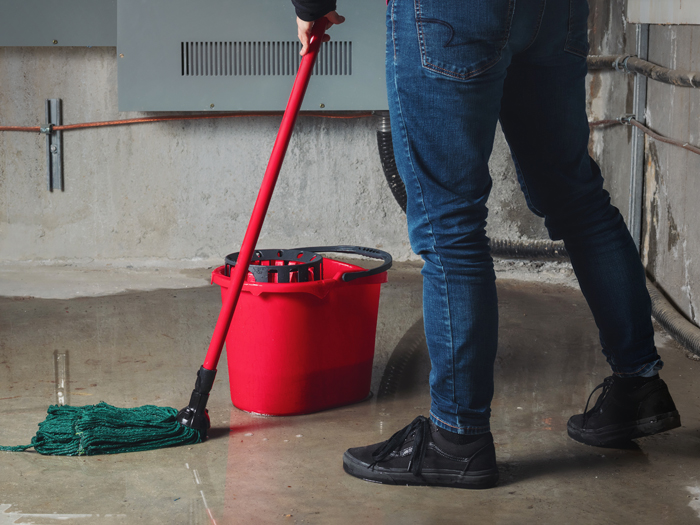Water Damage Is a Leading Cause of Commercial Real Estate Claims. How Sensor Technologies Help Mitigate These Claims

Commercial real estate insureds know how painful water damage claims can be.
These losses can happen suddenly from a pipe burst after freezing temperatures or they can happen gradually over time from improper installation or deterioration from aging infrastructure.
Water damage is one of the most common causes of property loss and is it one of the most costly with annual incurred loss amounts in the United States related to weather and non-weather water damage equal to $500 million, based on industry ISO data from 2021.
“Water damage is definitely impacting the commercial real estate industry,” said Rob Sullivan, real estate industry practice lead at The Hartford.
“It’s now a leading cause of commercial property losses across all real estate asset classes, as well as hospitality risks.”
In an already tough property market, the cost of water damage claims might have carriers considering how they can tighten their terms to remain profitable.
Insureds have already seen rate hikes and increasingly restrictive terms and conditions year after year.
Now, they might see separate water damage deductibles applicable to both weather and non-weather related events. Sullivan says they’ve become more common in the property market over the past three years or so.
“Based on individual risk characteristics, you might have a separate $50,000 water damage deductible, or even a separate $100,000 water damage deductible, along with a $25,000 AOP — all other peril deductible,” he explained.
As insureds navigate this hard market, many are looking for ways in which they can decrease water damage-related claims in order to better appeal to underwriters and control their total cost of insurance.
Non-weather-related water damage claims are a great candidate for mitigating losses because insureds can use sensor technologies to detect water intrusion issues before they cause major losses.
How Sensors Can Help Prevent Water Damage Claims
Leaky pipes, accidental discharge of sprinkler systems or issues with plumbing systems for example can all result in water damage in commercial real estate buildings.
These systems, known as non-weather-related water damage, can wreak havoc on a building and may go undetected.
Consider a leaky HVAC system.
Often, property managers will just flip on the system in springtime without checking for leaks, but they could be causing long-term damage. According to data from The Hartford, 75% of water damage losses are caused by plumbing, HVAC systems and other appliances that discharge liquid accidentally.
“A seal isn’t right, a pipe cracked and boom, there’s water damage, and it could be hidden or left undetected,” Sullivan said.
Sensors can help mitigate these kinds of losses. Placed on pipes and near systems where water may accidentally intrude, these tools can detect incursions and alert risk managers before they cause major damage.
The technology targets a variety of potential exposures and is often used by commercial real estate insureds to protect major assets.
“We focus on areas like data centers, utility rooms, and locations on the property that either have a higher risk of a leak or could have a more severe impact if a leak were to occur,” said Camryn Santos, director of strategy and IoT innovation at The Hartford.
“These devices are providing leak detection and temperature and humidity monitoring for things like freezing pipes or mold exposures. So, it really gives us an opportunity to hit at multiple perils.”
Additionally, risk managers can work with their carriers to implement sensor technologies that are suited for their particular type of building.
“We’re trying to get a little bit more consultative in figuring out the vulnerabilities of certain properties based on age, number of stories or the year it was built,” Santos said.
“There’s indicators that we can hone in on to say, ‘Okay, as a result of X, Y and Z, these are the types of preventative solutions that we’re recommending.’ And it changes sometimes based on the profile of the property.”
24/7 Real-Time Alerts
Once installed, these sensors alert risk managers of any potential incursion issues in real time, allowing them to take actions like shutting off water valves and calling in repair specialists immediately.
As with any tool, sensor technologies are only as good as the people using it. If sensors aren’t placed properly or if risk managers or facilities staff ignore the alerts, claims could still occur.
“We can always install technology, but if there’s no customer response to things like alerts or if the devices are not strategically placed around the property, we may still not get all the way there in protecting the property the way that it could be with the technology,” Santos said.
“If the alert goes off and it just goes off all weekend and nobody responds to it, we are still left with a loss — probably a large one.”
Commercial real estate owners and managers should establish a team, provide training, and have the team prepared to respond to a real time water sensor alert in a timely manner. Response time will play an important role in mitigating the water damage event.
“It really is about a formal implementation of what we would call a water damage prevention program,” Sullivan explained.
“That’s having a core team that is trained, that conducts a facility vulnerability risk assessment, that understands the potential sources of water intrusion, that knows where the shutoff valves are, that performs annual site inspections, that has mitigation efforts, has signed up restoration contractors and remediation contractors and does some type of annual check-in as they either acquire or sell properties,” he continued.
Risk Mitigation Can Result in Premium Savings
In addition to preventing claims, sensor technologies can help insureds appear more attractive to underwriters — a must given how tough the property market has been in recent years.
“We’re seeing progress over the past two years around risk mitigation and being more proactive in trying to address the issue, versus just absorbing rate increases year after year,” Sullivan said.
Sullivan and Santos relayed that The Hartford has spent years studying the effectiveness of sensor technologies, and it has found that they can be a key tool for mitigating claims.
That’s why The Hartford has started offering the program to many classes of insureds as part of the renewal process.
“The Hartford is totally bought in on water damage prevention devices, we believe the impact the technology can have in mitigating water losses is material and mutually beneficial for us and our insureds,” Santos said.
“The question is, how do you effectively deploy them, and how do you drive adoption and get people to feel comfortable with what you’re offering?”
By preventing claims from escalating, these technologies are becoming a key tool in a risk manager’s toolbox. Underwriters appreciate proactive risk management solutions and, over time, implementing preventative technologies like water sensors can reduce an insured’s premium. &











